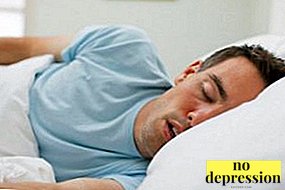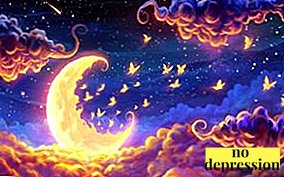People have dreams with different frequency. For some, dreaming is habitual phenomenon, for others - the exception rather than the norm.
Someone remembers them for a very long time, and someone forgets a few minutes after waking up. What does it mean if dreams visit a person nightly? Why does a person have dreams at all?
What is a dream?

Every day a person needs to stay about 8 hours in the dream.
At this time, he disconnects from the external environment, is not aware of what is happening around.
However, this period can not be called inactive - all physiological systems of the body continue to function, including the nervous one.
All sleep is a series of repetitive cycles lasting from 1.5 to 2 hours, which, in turn, consist of two main phases - slow and fast sleep.
Slow sleep characterized by slow breathing and muscle activity. At this time, a person does not observe dreams, and if you wake him up, he can recover for a long time, since brain activity also slows down.
But during fast sleep mental activity increases significantly. An encephalograph, a device that allows the recording of brain activity, shows the work of the brain, which is characteristic of the waking state, but neurons of the spinal cord remain disconnected at this time.
The fact is that it is in this phase that a person has dreams and, if he had the opportunity to move according to the plot of a dream, he could have unpredictable consequences.
With each new cycle, the time of slow sleep decreases, and the fast one increases. Therefore, closer to the morning we can see more dreamsthan 2-3 hours after falling asleep.
Causes of dreams

Why does a person see them?
There are several theories explaining reason for increased mental activity for a person during REM sleep and their meanings for a person:
- Job subconscious. Adherents of psychoanalytic theory, including its founder, Z. Freud, explain the emergence of dreams by the work of the unconscious, which thus tries to inform us about hidden desires and motives. According to this theory, the interpretation of dreams leads to a better understanding of the aspirations of man and his repressed desires, which have a huge impact on human behavior in reality.
At the same time, different people may experience the same images corresponding to any desire or inclination.
- Features of the brain. Psychiatrist D. Hobson ruled out the semantic load of dreams. During the fast phase of sleep, during which a person usually awakens, spontaneous impulses appear in the cerebral cortex, which the latter tries to interpret somehow, putting it into plots, sometimes characterized by a fair oddity. The basis of the plots in this case are often memories.
- Job of memory. The psychiatrist Zhang Jie put forward a version that explains the occurrence of dreams by a memorization mechanism - during sleep, information received by a person during the day is systematized, from short-term memory it is sent to a long-term one. The activation of these memories leads to the appearance of visions with a different plot.
- Simulation of emotions. Psychologist Mark Blencher suggested that in this way the human body models various situations in which the most acceptable emotional response is produced. That is why dreams are so filled with feelings and emotions.

Each theory has its supporters, but there is still no consensus on why nature created such a phenomenon as dreams.
Why are dreams?
Norm or pathology?
Constantly

Why does a person have dreams every night?
In fact, dreams occasionally dream of all people without exception - even, oddly enough, blind, but not all of them remember.
Awakening, many simply forget about them immediately. Bring the same to quickening of dreams in humans can the following factors:
- Intense rhythm of life. In such a situation, a person receives a lot of information from the outside world, which the brain is forced to process, which leads to increased mental activity even at night.
Frequent dreams in this case are not pathological, but they can say that a person is close to a stressful situation - perhaps he needs rest.
- Passion for current activities. Every person in life has periods of strong motivation for any activity when the whole consciousness is absorbed by an idea. At the same time and during sleep, the brain will make references to this activity. Most often at the same time and dream object hobbies. Creative individuals are particularly susceptible to this phenomenon.
- Impressionability. People who are prone to showing strong emotions can also often have dreams. At the same time, night visions can be both positive emotional and extremely negative.
- Tendency to depression and negative assessment. Individuals who are prone to depressive states and low self-esteem can often see nightmares that reflect their anxiety and fears. At the same time, such dreams can be obsessive, worsening the already negative emotional state.
In this case, it is better to contact a specialist - perhaps you should change your lifestyle, give yourself a rest, solve the problems that have accumulated and restore the normal emotional background.

Strange
Sometimes people are surprised at the absurdity of night visions, the plots of situations in the center of which they find themselves. but this is not a pathology.
Dreams are irrational in nature, because the mind of a person during sleep is turned off.

The subconscious mind involved in the creation of dream scenes, does not speak straightforwardly and logically - its language is figurative.
Strange scenes and images may appear in dreams, as they are symbolicand literally taking them would be wrong.
Bright
According to statistics, only 18% of people are confident that they see color dreams. And 63% find it difficult to answer whether they are painted or not.
Unfortunately, there is still no technology with which you can figure out this nuance, so you have to operate only with subjective impressions.
The same statistics show that mentally healthy people vivid dreams dream 20 times less than individuals with mental disorders. It is also more likely to see brightly colored images during night rest for people whose visions are negative.
However, the phenomenon of color sleep itself is not a diagnosis or pathology. Moreover, it appears that people with more high intellectual abilities also see painted dreams more often.

This is explained by the fact that such individuals have much more neural connections - that is, the amount of memory, respectively, a person can reproduce the corresponding picture in more detail.
Also color visions can talk about human creativityobserving them.
It is worth remembering that many of the ideas of his paintings are known Salvador Dali He took from his dreams.
It is noticed that with age, the ability to see vivid dreams in a person is lost. Most of these visions in young people.
Realistic
Some people have dreams that are as close to reality as possible. They have a well-coordinated plot, the picture contains a lot of the smallest details, and the man himself behaves in the most natural way. Most often such visions reflect those situations that are familiar to him in reality.
For example, a person who knows his professional duties well and has a long work experience, can see in all details the situation that takes place in reality, because he has repeatedly encountered this.

Also in such dreams one often sees well-known people, relatives or close friends - a situation or picture that has been repeatedly beaten up in life. can in high detail appear to man in night vision.
Color, bright, unusual and very realistic dreams are not in themselves some kind of pathology.
It is worth paying attention to them when they are obsessive or make a person feel negative emotions that are projected onto reality.
Why does a person have dreams:



